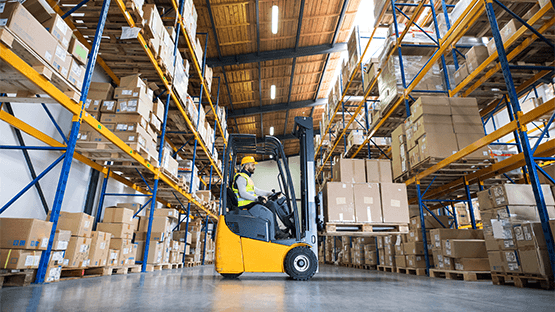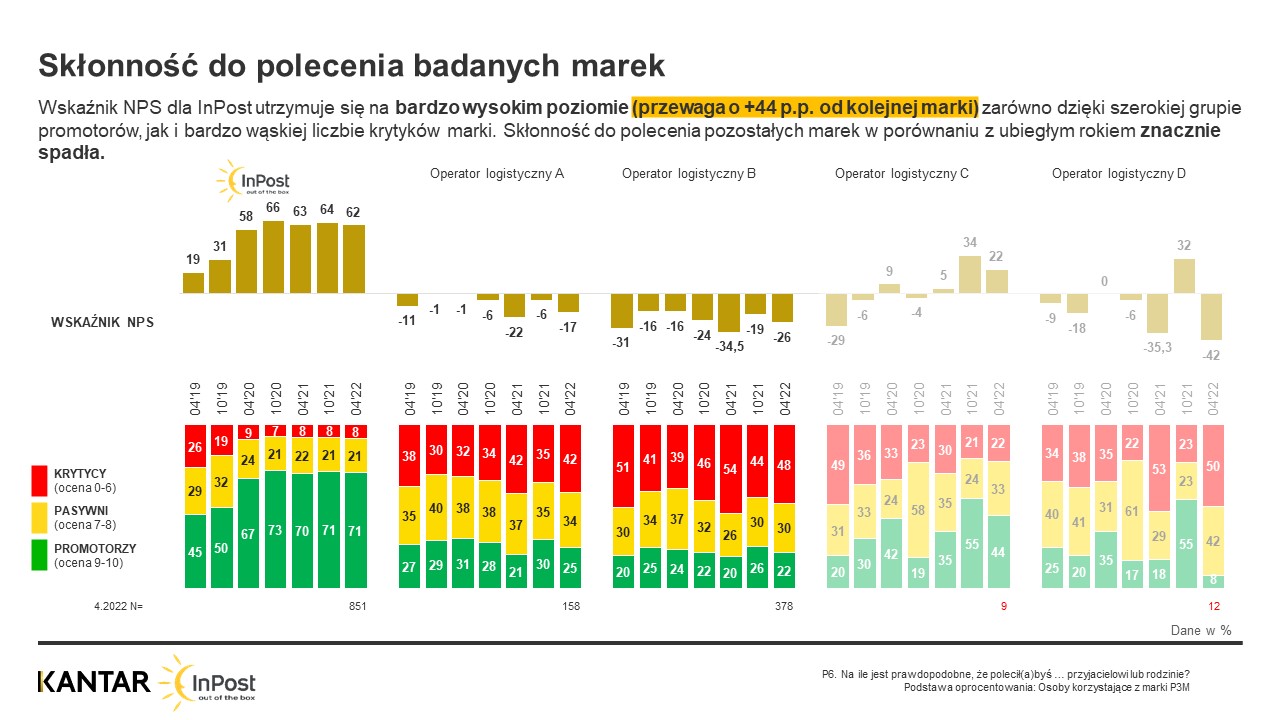Impact of the market situation on e-commerce and fulfillment services


25 August 2022
The past two years have been an Eldorado of sorts for the e-commerce industry. Pandemic-related restrictions and consumer fears meant that both the number of orders from online shops and the shoppers themselves, who had hitherto had no connection with online shopping, were on the rise. However, the start of 2022 has brought negative developments in this area.
Market situation after the pandemic
According to CSO data, since April, e-commerce sales have recorded year-on-year declines for three consecutive months. [1] April itself ended with e-commerce's share of total retail sales at 8.9%, compared to 9.4% in March. Industries not directly related to necessities suffered the most: newspapers and books, clothing footwear and white goods, household appliances and furniture.
Potential reasons for this include the fact that virtually all pandemic restrictions were lifted at the beginning of 2022 and traditional trade picked up again, taking back some of the slice of the pie seized by e-commerce. However, the scale and speed of the decline indicates that there is more behind it than just an expected correction after a sharp and unexpected rise.
Among the factors influencing declines in e-commerce, one can certainly include the situation related to the still obstructed supply chain from Asia, causing shortages of imported products. Another reason for declines in purchases may also be uncertainty and insecurity related to the current geopolitical situation, which undoubtedly affects consumer sentiment.
Economic condition and e-commerce
Rapidly accelerating inflation may also be one of the key factors contributing to lower sales in the e-commerce sector. Rising prices have resulted in a marked decrease in the so-called disposable amounts in household budgets. If spending on groceries, utilities, fuel is increasing and consuming an increasing proportion of the monthly wallet - the amount of money that can be spent on non-core goods is significantly decreasing.
The consumer then makes the difficult but conscious decision that he can forgive himself this month to buy another book or CD and the next month to buy a new jacket. He or she will then reassert the belief that since the old fridge still works, even though it is old and out of date, he or she will not replace it with a new one, but will postpone the expense until other times.
While it seems too early to determine which of these circumstances is decisive for e-commerce declines, the declines themselves are a non-negotiable fact and e-tailers have to face the consequences.
Negative factors on the cost side of e-commerce logistics are also contributing to this situation. The spike in fuel prices is already translating into rising shipping costs. The significant increase in the cost of packaging and fillers is also not insignificant. Also, the increase in minimum wages and the problem with labour supply is pushing the cost of labour upwards, which directly translates into increased costs for e-commerce logistics services.
All this together creates a very unfavourable environment for e-commerce, in which we are faced with falling revenues on the one hand and rising costs on the other. Conscious e-business owners face quite a challenge and are forced to fight on two fronts simultaneously. On the one hand, they face the effort of acquiring as many customers as possible from the recently shrinking pool by taking them away from the competition. On the other hand, optimising logistics costs at every level - from warehousing to operations and packaging up to and including shipments - is becoming a major task.
Fighting for your piece of the pie
Taking the field away from the competition is a difficult task, and one for which you can try to use a whole portfolio of tools. For some, the solution will be to spend more on e-marketing and getting as many hits as possible, but it is important to remember that CPC (Cost Per Click) is not insignificant, and sales really come from conversions, i.e. our ability to convince a buyer who has already visited our site to complete the purchase.
The way to win over customers is to place emphasis on highly personalising the offer, making it different and unique from the competition. This can be done through the choice of products, or through other unique parameters such as the way of packaging, freebies and extras, additional services.
Another option is to attract as many 'latecomers' as possible, i.e. customers who are reminded of the need to buy late and would like to collect their parcel the following day. This can be achieved by declaring and actually implementing fast shipping, i.e. shipping on the day the order is placed.
While doing so, it is important to keep in mind the key aspects of this activity, which are the capacity of our e-commerce warehouse (how many orders per hour we can pack) and the courier's drive-up window (the latest possible time at which packed parcels will still be collected and put into the courier distribution network.
It is only when these two aspects are set at the right level and in tune with each other that we can, in practice, ensure a very late cut-off-time (the hour by which orders placed are dispatched the same day) and be able to put up a real fight against the competition. For many consumers, 'tomorrow's delivery' can be a decisive factor, causing them to order a product from us rather than a competitor.
How does carrier choice affect e-commerce success?
Another way to retain and perceive customers' competition is to match the service to their expectations as closely as possible. The method and quality of delivery is an integral and important part of a positive shopping experience. When selecting carriers for their offering, the e-tailer should be guided by consumer preferences.
The research conducted by Kantar quite clearly indicates their preferences. Both the NPS index (Net Promoter Score) and the share of so-called promoters among e-commerce customers using the services of various carriers unequivocally put InPost in first place, practically outclassing the competition for several years. In an era of potential sales declines for e-businesses, it is crucial to offer those consumers who continue to buy online the delivery methods they expect and which give them a high level of satisfaction.

The decline in the number of orders and their uneven distribution over time also causes serious disruption on the in-house logistics side of e-stores. Fixed costs for infrastructure maintenance are rising, and labour-related costs also no longer "tie in" with irregular sales revenues. In the face of such a challenge, the use of a fulfilment operator may prove to be a good solution. Even if nominally the prices of the individual operations remain the same, the billing structure will help match costs to revenues by converting a significant fixed cost ratio into variable costs - as is the case when using InPost as a logistics operator.
As part of the fulfilment service provided by InPost, owners of e-shops may not only flexibly account for the storage of goods and individual activities (orders, returns) according to the principle "you only pay for what is done". Cooperation within this service also gives the recipients a chance for a very late cut-off-time, i.e. up to 8 p.m., and the possibility of using attractive discounts for delivery services provided by Paczkomat® InPost, as well as directly to customers' homes by InPost couriers.
[1] Source: https://obserwatorlogistyczny.pl/2022/05/24/gus-w-kwietniu-udzial-e-commerce-w-sprzedazy-detalicznej-spadl-do-poziomu-89/
Rozwiń swój biznes z InPost Fulfillment
Magazynowanie, pakowanie, wysyłka – nie musisz tego robić sam! Oddaj to w ręce profesjonalistów.
Poświęć 1 minutę i zostaw kontakt do siebie, aby zyskać więcej czasu i zredukować koszty.
- Błyskawiczna dostawa
- Redukcja kosztów
- Zero problemów z wysyłką
- Obsługa szczytów sprzedaży
- Oferta szyta na miarę
Czytaj również

Comprehensive customer service. How to determine the needs of a potential customer in e-commerce?
Competition in e-commerce is fierce and winning a customer does not yet mean success. Whether they decide to make a purchase and come back...

When is a good time to move your warehouse to InPost Fulfillment?
Warehouse management is a fundamental part of e-commerce operations. Many online retailers realise after a while that handling the logisti...

Catching the customer's attention, arousing his or her interest and getting him or her to perform a specific task - most often the purchas...



